This is a post about the theory of the three worlds and continues the post about the perception of the octave.
Does the coincidence of the three worlds only work for the octave?
The octave demonstrates how mathematics (Platonic world) enters the physical world, and how this convergence of mathematics (integral numbers) and physics (vibrating matters) gives rise to a very special phenomenon, namely resonance. This resonance, in turn, is perceived by us human subjectively (Penrose: mental world) in quite a special way: We subjectively recognise two tones at an octave’s distance from each other as identical tones. Each of us – regardless of our cultural background – perceives a tone with twice the frequency as the “same” tone (Happy Birthday experiment).
If the frequency ratio (mathematics) deviates even only very slightly, the resonance will disappear (physics) and the tones will (mentally) strike us as different, and their simultaneous sound as a dissonance.
The octave as the first overtone thus combines the three worlds. Can we extend this success and use the further overtones following the octave for our musical scale too? The answer to this question is not a simple yes, for the mathematical series of integers has to fit in with the constraints of the physical and mental worlds.
What constraints are these? And what is a musical scale in the first place?
Constraints in the physical and mental worlds
Sounds are used to communicate, and mammals and human beings communicate acoustically. They are able to generate sounds and to hear them. These physical/mental circumstances must be taken into account if we consider how musical scales came into being.
We are unable to produce pitches of any frequency with our voices. And if two tones are far apart from their frequency, we find it difficult to measure their mutual distance (mental, subjective world). Therefore the notes of a musical scale must not be too far apart. This is the first constraint of the physical and mental world in the formation of musical scales.
This physical/mental constraint can be further substantiated and specified: since we perceive a second note an octave higher as the “same” tone (Happy Birthday experiment), a musical scale must not exceed the range of an octave. If it did, the musical scale would overlap with itself because tones outside the octave would immediately find a “same” tone within the octave. For this reason, a musical scale is always limited to the range of an octave, as is the case in all musical cultures.
On the other hand, the notes must not be too close together, for if they were, we would not be able to differentiate between them any longer. A musical scale must therefore not have any number of notes – even though this would be perfectly conceivable in mathematical terms. Yet not everything that is mathematically possible makes sense in reality.
The consequences of these conditions for musical scales can be summarised in two points:
- The notes of a musical scale must be inside the range of an octave.
- A musical scale must not consist of too many notes.
This is the physical/mental constraint for musical scales.
How can convincing musical scales come into being under these constraints? Can they still be scales with simple mathematical ratios? → next post
This is a post about the theory of the three worlds.
